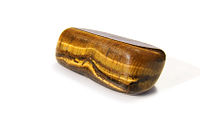- Chatoyancy
-
In gemology, chatoyancy (
 /ʃəˈtɔɪ.ənsi/ shə-toy-ən-see), or chatoyance, is an optical reflectance effect seen in certain gemstones. Coined from the French "œil de chat," meaning "cat's eye," chatoyancy arises either from the fibrous structure of a material, as in tiger eye quartz, or from fibrous inclusions or cavities within the stone, as in cat's eye chrysoberyl. The effect can be likened to the sheen off a spool of silk: The luminous streak of reflected light is always perpendicular to the direction of the fibres. For a gemstone to show this effect best it must be cut en cabochon, with the fibers or fibrous structures parallel to the base of the finished stone. Faceted stones are less likely to show the effect well.
/ʃəˈtɔɪ.ənsi/ shə-toy-ən-see), or chatoyance, is an optical reflectance effect seen in certain gemstones. Coined from the French "œil de chat," meaning "cat's eye," chatoyancy arises either from the fibrous structure of a material, as in tiger eye quartz, or from fibrous inclusions or cavities within the stone, as in cat's eye chrysoberyl. The effect can be likened to the sheen off a spool of silk: The luminous streak of reflected light is always perpendicular to the direction of the fibres. For a gemstone to show this effect best it must be cut en cabochon, with the fibers or fibrous structures parallel to the base of the finished stone. Faceted stones are less likely to show the effect well.Gem species known for this phenomenon include the aforementioned quartz, chrysoberyl, beryl (especially var. aquamarine), tourmaline, apatite, moonstone and scapolite. Glass optical cable can also display chatoyancy if properly cut, and has become a popular decorative material in a variety of vivid colors.
The term Cat's Eye, when used by itself as the name of a gemstone, can only be used to refer to a Cat's Eye Chrysoberyl. Any other stone exhibiting this phenomenon must have the stone's name after the Cat's Eye identifier, e.g., Cat's Eye Aquamarine.
Chatoyancy can also be used to refer to a similar effect in woodworking, where certain finishes will cause the wood grain to achieve a striking three-dimensional appearance.[1] This effect is often highly sought after, and is sometimes referred to as "wet look", since wetting wood with water often displays the chatoyancy, albeit only until the wood dries. Oil finishes and shellac can bring out the effect strongly.
See also
- Asterism (gemology)
- Optical phenomenon
References
- Webster, R., Jobbins, E. A. (Ed.). (1998). Gemmologist's compendium. St Edmundsbury Press Ltd, Bury St Edwards.
- Mitchell, T. et al. Proceedings of the Electron Microscopy Society of America (EMSA), 1984.
Categories:- Mineralogy
- Optical phenomena
Wikimedia Foundation. 2010.


